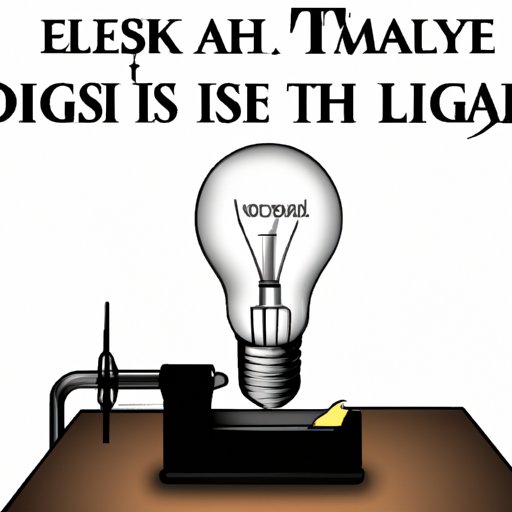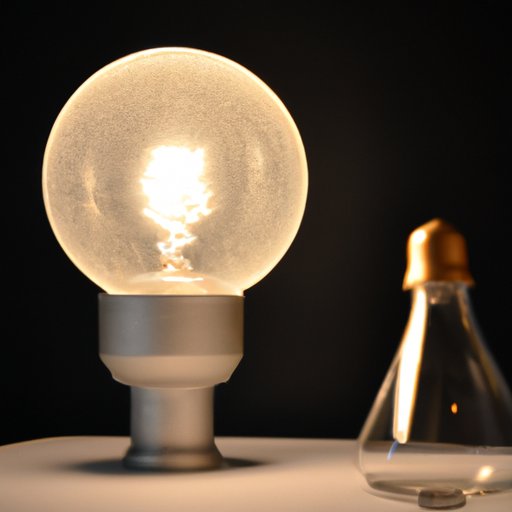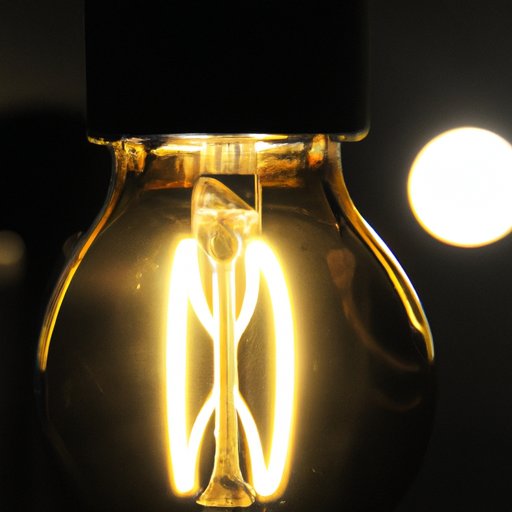Introduction
Electric lighting has revolutionized the way we live our lives, from illuminating dark roads and public spaces to providing a source of comfort and security at night. But who was responsible for this amazing innovation? Many people believe that Nikola Tesla invented the light bulb, but is this really true? This article will explore the history of electric lighting, examine Tesla’s contribution to the development of electric lighting, and look at how his ideas led to future innovations.
Exploring the History of Electric Lighting
Electric lighting has been around since the early 19th century when Humphry Davy experimented with electricity and created an arc lamp in 1809. While Davy’s lamp was revolutionary, it was not practical for everyday use due to its high cost and complexity. Other inventors such as Warren de la Rue and Joseph Swan continued to experiment with electric lighting, but it wasn’t until Thomas Edison’s inventions in 1879 that electric lighting became a reality.
Examining the Impact of Tesla’s Innovations in Illumination
Although Tesla did not invent the light bulb, he made several important contributions to the development of electric lighting technology. Tesla developed the first alternating current (AC) induction motor in 1887, which enabled the widespread use of AC power and allowed for the development of more efficient lighting systems. He also developed a system of fluorescent lamps and demonstrated them in 1889, although they were not widely adopted until much later. Finally, Tesla was a proponent of using arc lamps for street lighting, which eventually led to the development of modern street lighting systems.

Debunking the Myth of Tesla and the Light Bulb
Despite Tesla’s significant contributions to electric lighting, he did not invent the light bulb. That honor belongs to Thomas Edison, who developed the first commercially viable incandescent light bulb in 1879. Edison’s design was based on previous work by other inventors, including Joseph Swan and Warren de la Rue, who had already developed working prototypes of incandescent light bulbs. Edison improved upon these designs and was able to create a reliable and affordable light bulb that could be used in homes and businesses.

The Role of Tesla in the Development of Electric Lighting
Tesla certainly played an important role in the development of electric lighting. His AC induction motor revolutionized the use of electricity and enabled the development of more efficient lighting systems. His experiments with fluorescent lamps also led to their eventual adoption in the 20th century. However, it is important to note that Tesla did not invent the light bulb – he merely contributed to its development and evolution.
Thomas Edison’s Revolutionization of Electric Lighting
Thomas Edison’s invention of the incandescent light bulb in 1879 revolutionized electric lighting. Edison’s design was based on the work of earlier inventors, but he was able to make improvements that made it more reliable and affordable. Edison’s invention was the first commercially viable light bulb and it quickly became the standard for electric lighting.

A Look at the Contribution of Other Inventors to Electric Lighting
While Edison is often credited with inventing the light bulb, there were many other inventors who contributed to the development of electric lighting. Humphry Davy experimented with arc lamps in the early 19th century, while Joseph Swan and Warren de la Rue both developed working prototypes of incandescent light bulbs before Edison’s design. These inventors all played an important role in the development of electric lighting and without their contributions, Edison’s invention would not have been possible.
Understanding Tesla’s Influence on Electric Lighting Technology
Tesla’s contributions to electric lighting were significant and his ideas led to many innovations in the field. His AC induction motor enabled the widespread use of AC power, while his experiments with fluorescent lamps eventually led to their adoption in the 20th century. Tesla’s ideas also inspired further research into arc lamps, which eventually led to the development of modern street lighting systems.
Tesla’s Impact on Modern Electric Lighting Technology
Tesla’s influence on modern electric lighting technology can still be seen today. His AC induction motors are still used in many electrical appliances, while fluorescent lamps continue to be a popular choice for lighting. Tesla’s ideas also inspired further research into arc lamps, which led to the development of modern street lighting systems. Tesla’s influence on electric lighting technology is undeniable and his contributions are still felt today.
How Tesla’s Ideas Led to Future Innovations
Tesla’s ideas and innovations have inspired generations of inventors to pursue new technologies and push the boundaries of what is possible. His experiments with arc lamps and fluorescent lamps eventually led to the development of modern lighting systems such as LED lighting. His AC induction motor also enabled the widespread use of AC power, which is still used today in many electrical appliances. Tesla’s ideas and innovations have had a lasting impact on modern electric lighting technology.
Conclusion
It is clear that Tesla did not invent the light bulb, but his contributions to electric lighting technology were significant. His AC induction motor revolutionized the use of electricity and enabled the development of more efficient lighting systems. His experiments with fluorescent lamps also led to their eventual adoption in the 20th century. Tesla’s influence on modern electric lighting technology is undeniable and his ideas have led to many future innovations.
Summary of Tesla’s Contributions to Electric Lighting
Tesla’s contributions to electric lighting were significant and his ideas have had a lasting impact on modern electric lighting technology. He developed the first AC induction motor, which enabled the widespread use of AC power and allowed for the development of more efficient lighting systems. He also developed a system of fluorescent lamps and demonstrated them in 1889, although they were not widely adopted until much later. Finally, Tesla was a proponent of using arc lamps for street lighting, which eventually led to the development of modern street lighting systems.
Final Thoughts on Tesla’s Role in the Development of Electric Lighting
Tesla may not have invented the light bulb, but his contributions to electric lighting technology were significant. His ideas and innovations have had a lasting impact on modern electric lighting technology and have inspired generations of inventors to pursue new technologies and push the boundaries of what is possible. Tesla’s influence on electric lighting technology is undeniable and his contributions are still felt today.
(Note: Is this article not meeting your expectations? Do you have knowledge or insights to share? Unlock new opportunities and expand your reach by joining our authors team. Click Registration to join us and share your expertise with our readers.)
